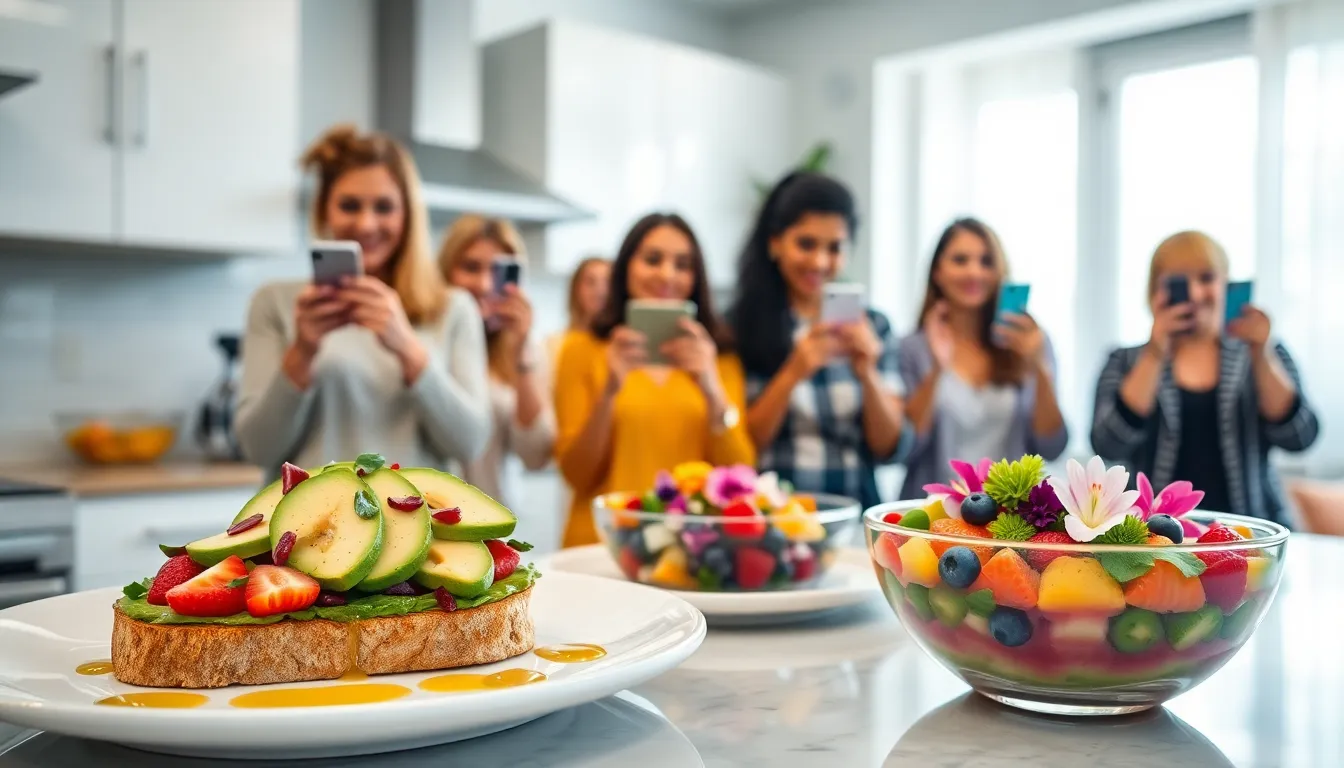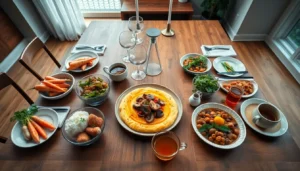Table of Contents
ToggleIn the digital age, food has morphed from mere sustenance into a full-on sensory experience, thanks to the power of social media. Ever wondered why your favorite pizza or smoothie bowl suddenly looks like it belongs on the cover of a magazine? It’s all about the aesthetics. As you scroll through your feeds, it’s impossible to overlook the deliciously curated snapshots that not only tantalize your taste buds but also influence your culinary choices. From the rise of Instagram-worthy dishes to the bizarre food challenges taking over TikTok, we’re diving into the hot trends shaping our plates today. Grab your virtual fork, let’s dig in.
The Rise of Visual Aesthetics in Food Photography

The visual presentation of food has become paramount in today’s social media landscape. Platforms like Instagram and Pinterest have transformed simple dishes into detailed works of art, influencing what people eat and how they present their meals. Food styling has evolved: people experiment with vibrant colors, textures, and plating techniques to create eye-catching visuals. Think avocado toast with a perfect drizzle of olive oil or a rainbow smoothie bowl topped with edible flowers. All of this isn’t just for show: it’s about engagement. Posts that look stunning garner more likes, remixes, and shares. It’s a recipe for success in the digital age, where aesthetics reign supreme and chic eateries boast of their Instagrammable corners.
Photography isn’t merely an accessory: it’s the star of the show. Even home cooks arm themselves with ring lights and slick editing apps to make their weekly meals look like culinary masterpieces. Engaging with food content online has created a culture where taste is measured not just by flavor, but by its photogenic qualities.
Impact of Instagram Influencers on Food Choices
Instagram influencers have become the new food critics, wielding their influence like a chef with a spatula. They’ve turned food experiences into shareable content, and followers trust them to recommend the latest culinary discoveries. This influencer culture is not just about endorsements: it’s about authenticity and relatability. When a foodie influencer recommends a hidden gem of a taco shop or shares their take on a trendy vegan burger, their followers are likely to flock there, driven by the desire to be part of the same experience.
Influencers have also introduced diverse food cultures and dishes to their audiences. Many patrons find themselves trying foods they had never considered before, perhaps a spicy Korean dish or a trendy fusion food, simply because they saw it on their favorite influencer’s feed. The importance of this impact cannot be understated, as it shapes not only individual choices but also larger dining trends, leading restaurants to curate menus based on what’s trending online.
Emerging Taste Sensations and Flavor Combinations
As culinary exploration becomes more accessible, new taste sensations and flavor combinations frequently emerge on social media. Innovative pairings like chili mango ice cream or miso caramel sauce challenge palates and spark curiosity among foodies. These unusual combinations often make waves on platforms like TikTok or Instagram, where videos quickly go viral.
Some trends have even kicked off specific movements, such as the obsession with fusion cuisine that combines unexpected ingredients from different cultural backgrounds. For example, sushi burritos or bao burgers have become neighborhood staples, pushing boundaries and recreating traditional tastes. These experimental creations entice adventurous eaters while inspiring others to try cooking them at home, accelerating their popularity.
Viral Recipes and Challenges: A New Culinary Frontier
Social media is the new playground for viral recipes and cooking challenges. Whether it’s the whipped coffee phenomenon of 2020 or banana bread challenges during lockdowns, these trends have sparked a collective cooking experience that goes beyond individual kitchens. The beauty of these viral sensations lies in their simplicity: they require minimal ingredients yet deliver maximum impact, making them perfect for everyday users wanting to spice up their cooking without breaking a sweat.
Challenges often elicit enthusiastic participation from followers eager to share their attempts, leading to a snowball effect. Users post their results, providing a gallery of culinary creativity. The interaction creates a sense of community, and suddenly, everyone feels like a chef in their own right, all thanks to the power of social media.
Sustainability and Ethical Eating: A Growing Concern
As awareness around sustainability rises, so do trends reflecting ethical eating practices. Social media platforms have become vital spaces to discuss and share sustainable practices. Influencers and creators highlight plant-based diets, zero waste cooking, and locally sourced ingredients, urging followers to be more mindful of their food choices.
Veganism, once considered niche, has moved into the mainstream thanks to beautifully presented plant-based dishes flooding feed. Users are increasingly eager to adopt diets that not only promise health benefits but also promote environmental well-being. These movements encourage conversations about food origins, processing, and the implications of dietary choices on the planet. As this trend continues to gain momentum, dining experiences are poised to change, featuring more environmentally responsible practices and dishes inspired by the ethos of sustainability.
Regional and Global Influences on Food Trends
The world has become a village thanks to the internet, and food trends reflect this exciting globalization. Regional cuisines from around the globe have found their way onto the social media stage. Whether it’s a vibrant Thai curry or artisanal Italian pasta, culinary boundaries blur as ingredients and techniques travel across borders.
People are seeking authenticity in their food experiences, prompting restaurants to offer globally inspired dishes that showcase distinctive flavors. Fusion cuisine continues to thrive, with chefs merging elements from various cultures to create innovative menus. As users share their multicultural dining experiences online, this blend of influences fosters appreciation for global gastronomy.
The Future of Food Trends on Social Media
Projecting into the future, food trends on social media appear poised for further evolution. The appetite for visual content will only grow, demanding even more creativity in food presentation and aesthetics. Expect to see more niche communities emerge, catering to various dietary preferences like gluten-free or keto-friendly dishes, as followers seek tailored content.
Also, as social media algorithms evolve, personalization will become key in influencing what users see, shaping food choices through curated feeds. Brands positioning themselves as leaders in understanding consumer preferences will thrive, leveraging data to connect more effectively with audiences. Staying ahead of trends becomes essential for those within the food industry, as social media remains a powerful tool for influence and engagement.




